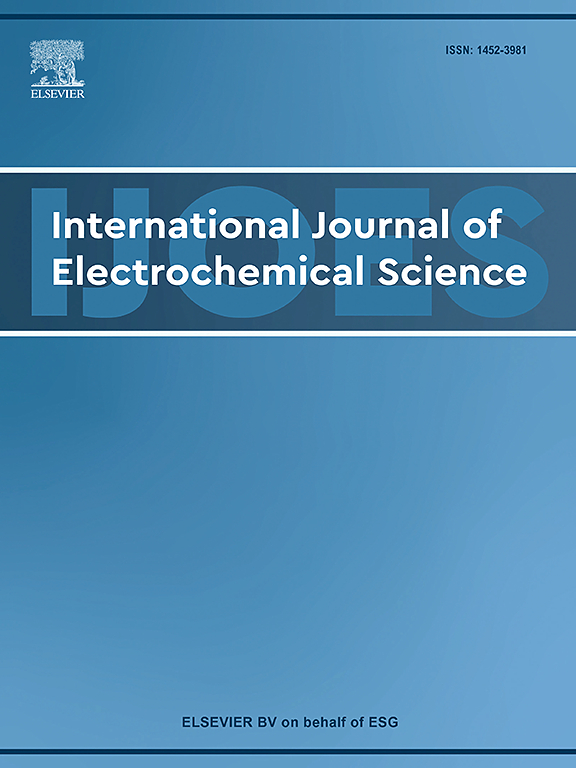电化学传感器精确检测水中重金属离子的研究进展综述
IF 2.4
4区 化学
Q4 ELECTROCHEMISTRY
International Journal of Electrochemical Science
Pub Date : 2025-10-14
DOI:10.1016/j.ijoes.2025.101209
引用次数: 0
摘要
水污染是一项重大的全球环境挑战,重金属离子构成了一类主要污染物。这些有毒离子通过多种途径进入人体,包括饮用受污染的饮用水、皮肤接触和在食物链中的生物积累。由于其毒性高,生物蓄积潜力强,排泄速度慢,一旦引入,将对健康造成严重危害。这些特征使它们能够随着时间的推移而积累,对生态系统和公共卫生造成长期威胁。解决这些风险需要开发高度敏感、准确和可靠的检测方法,以有效监测和识别重金属污染物,从而确保环境监测和公众健康保护。电化学传感装置在有毒金属离子的鉴定和定量中日益突出的特点是其成本低,选择性高,灵敏度高,并且能够达到非常低的检测限。本文综述了用于监测水中重金属的电化学传感平台的最新进展,并指出了未来研究的新兴方向。这篇综述的结构是首先检查电极的制造策略,详细介绍了电极的性质和通过各种方法生产的电极的特征。其次,综述了电极修饰的研究进展,重点介绍了各种修饰材料,包括无机化合物、有机框架和生物材料。随后,讨论了支持分析框架的进展,包括信号识别、数据处理和支持智能分析的预测建模算法。最后,对电化学传感技术的发展趋势进行了总结,并对可靠、精确地检测重金属离子的新型电化学传感技术的发展提出了展望。本文章由计算机程序翻译,如有差异,请以英文原文为准。
Recent progress of electrochemical sensors for accurate detection of heavy metal ions in water: A comprehensive review
Water pollution represents a critical global environmental challenge, with heavy metal ions constituting a major class of contaminants. These toxic ions enter the human body through multiple pathways, including the consumption of contaminated drinking water, dermal contact, and bioaccumulation in the food chain. Once introduced, they pose severe health risks due to their high toxicity, strong bioaccumulation potential, and slow excretion rate. Such characteristics enable them to accumulate over time, creating long-term threats to both ecosystems and public health. Addressing these risks requires the development of highly sensitive, accurate, and reliable detection methods to monitor and identify heavy metal pollutants effectively, thereby ensuring environmental monitoring and public health protection. The growing prominence of electrochemical sensing devices in the identification and quantification of toxic metal ions is attributed to their low cost, high selectivity, exceptional sensitivity, and ability to achieve very low detection limits. This review provides a comprehensive overview of recent developments in electrochemical sensing platforms for monitoring heavy metals in aqueous environments and identifies emerging directions for future research. The review is structured to first examine electrode fabrication strategies, detailing the properties of electrodes and the characteristics of electrodes produced through various methods. Next, it reviews research progress concerning the modification of electrodes, emphasizing a variety of modifying materials, including inorganic compounds, organic frameworks, and biomaterials. Subsequently, progress in the supporting analytical frameworks is discussed, including signal recognition, data processing, and predictive modeling algorithms that enable intelligent analysis. Finally, current trends in electrochemical sensing are summarized, and perspectives are offered for the development of novel electrochemical sensor technologies for reliable and precise detection of heavy metal ions.
求助全文
通过发布文献求助,成功后即可免费获取论文全文。
去求助
来源期刊
CiteScore
3.00
自引率
20.00%
发文量
714
审稿时长
2.6 months
期刊介绍:
International Journal of Electrochemical Science is a peer-reviewed, open access journal that publishes original research articles, short communications as well as review articles in all areas of electrochemistry: Scope - Theoretical and Computational Electrochemistry - Processes on Electrodes - Electroanalytical Chemistry and Sensor Science - Corrosion - Electrochemical Energy Conversion and Storage - Electrochemical Engineering - Coatings - Electrochemical Synthesis - Bioelectrochemistry - Molecular Electrochemistry

 求助内容:
求助内容: 应助结果提醒方式:
应助结果提醒方式:


